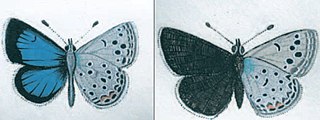
Plumbaginaceae is a family of flowering plants, with a cosmopolitan distribution. The family is sometimes referred to as the leadwort family or the plumbago family.

Acantholimon is a genus of small flowering plants within the plumbago or leadwort family, Plumbaginaceae. They are distributed from southeastern Europe to central Asia and also in South America, but also cultivated elsewhere in rock gardens.

Pierre Edmond Boissier was a Swiss prominent botanist, explorer and mathematician. He was the son of Jacques Boissier (1784-1857) and Caroline Butini (1786-1836), daughter of Pierre Butini (1759-1838) a well-known physician and naturalist from Geneva. With his sister, Valérie Boissier (1813-1894), he received a strict education with lessons delivered in Italian and Latin. Edmond's interest in natural history stemmed from holidays in the company of his mother and his grandfather, Pierre Butini at Valeyres-sous-Rances. His hikes in the Jura and the Alps laid the foundation of his zest for later exploration and adventure. He attended a course at the Academy of Geneva given by Augustin Pyramus de Candolle.

The wildlife of Morocco is composed of its flora and fauna. The country has a wide range of terrains and climate types and a correspondingly large diversity of plants and animals. The coastal areas have a Mediterranean climate and vegetation while inland the Atlas Mountains are forested. Further south, the borders of the Sahara Desert are increasingly arid. Large mammals are not particularly abundant in Morocco, but rodents, bats and other small mammals are more plentiful. Four hundred and ninety species of birds have been recorded here.
Acantholimon koeycegizicum, is a species of plant belonging to the family Plumbaginaceae.
Acantholimon goeksunicum is a species of plant belonging to the family Plumbaginaceae. It is only found on calcareous steppes in southeastern Anatolia (Turkey).

As of 2000 about 9300 species of vascular plant were known to grow in Turkey. By comparison, Europe as a whole contains only about 24% more species, despite having thirteen times the area.

Lake Nemrut is a freshwater crater lake in Bitlis Province, eastern Turkey. It is part of Nemrut Caldera, a volcanic caldera atop Volcano Nemrut. The caldera is a registered natural monument and the wetland is registered as a Ramsar site of the country.

Colias sagartia is a butterfly of the family Pieridae. It is found in the Elburz mountains in northern Iran and the mountains of north-western Iran.

Turanana cytis, the Persian odd-spot blue, is a butterfly of the family Lycaenidae. It was described by Hugo Theodor Christoph in 1877. It is found in the Turkey, the Kopet-Dagh and Iran.

Turanana endymion, the odd-spot blue or Anatolian odd-spot blue, is a butterfly of the family Lycaenidae. It was described by Christian Friedrich Freyer in 1850. It is found in Turkey, Lebanon and Iran. Records from Europe refer to Turanana taygetica.
Turanana taygetica is a butterfly of the family Lycaenidae. It was described by Rebel in 1902. It is found in Greece and Turkey.
Acantholimon gabrieljaniae, or Gabrielyan's prickly thrift, is a species of leadwort that is endemic to Armenia. It is found only in the Sevan floristic region, and is only known from its type specimen. It may be related or synonymous to A. bracteatum. It grows on limestone slopes at elevations around 2,000 m. It is threatened by nomadic livestock farming, which can degrade and destroy its habitat. The type specimen was found in the Sevan National Park, and so is afforded some protection.
Acantholimon vedicum, the Vedian prickly thrift, is a species of leadwort that is endemic to central Armenia, and is only found in the Yerevan floristic region, on the limestone massif Erakh between elevations of 900–1,000 m, close to the city of Vedi. It is only known from its type specimens, and little is known of this species. It is threatened by nomadic livestock farming, which can lead to habitat loss and degradation.

The Eastern Anatolian montane steppe is a temperate grasslands, savannas, and shrublands ecoregion. It is located in high plateau of Eastern Anatolia, covering parts of eastern Turkey, Armenia, Azerbaijan, southern Georgia, and northwestern Iran.

Acantholimon libanoticum(Lebanese prickly thrift, غملول لبناني) is a plant in the family Plumbaginaceae first described by Pierre Edmond Boissier. It is native to Western Asia from Turkey to Syria and Lebanon.

The Pamir alpine desert and tundra ecoregion covers the high plateau of the Pamir Mountains, at the central meeting of the great mountain ranges of Central Asia: Himalaya, Karakoram, Hindu Kush, Kunlun, and Tian Shan. It is a region of relatively high biodiversity due to its central location and high elevation differentials, but it also acts as a barrier between the climate and habitats of north and south Asia.

The Sulaiman Range alpine meadows ecoregion covers a series of higher altitude mountain ranges along the crest of the Sulaiman Mountains, a southerly extension of the Hindu Kush Mountains along the Afghanistan-Pakistan border. The area is relatively undeveloped, with about a third of the terrain either forested or in 'alpine steppe' shrub or herbaceous cover.
Alexander Gilli was an Austrian botanist and pteridologist. He was a pioneer in research on plant communities.
Acantholimon gillii is a species of plant described by Karl Heinz Rechinger and Mogens Engell Köie. Acantholimon gillii is part of the genus Acantholimon and the family Plumbaginaceae. No subspecies are listed in the Catalog of Life.












